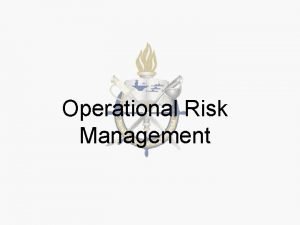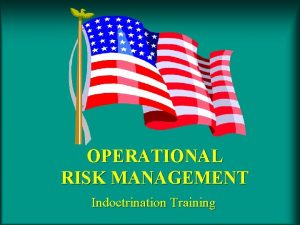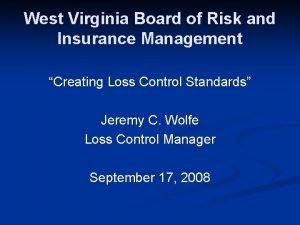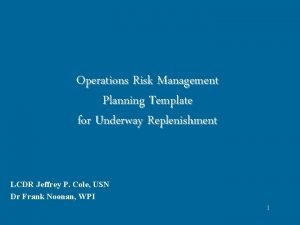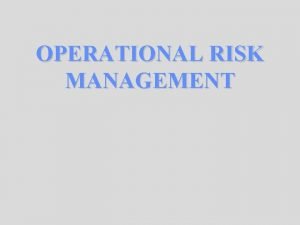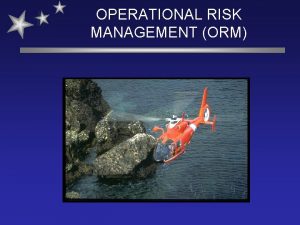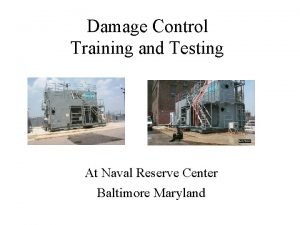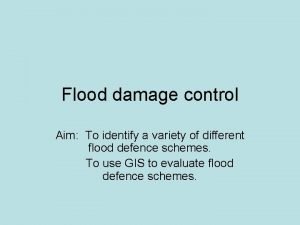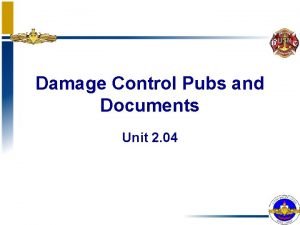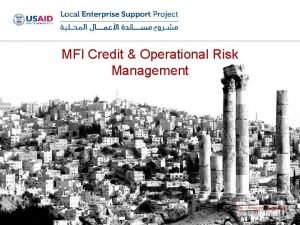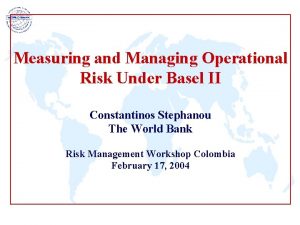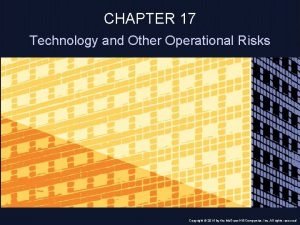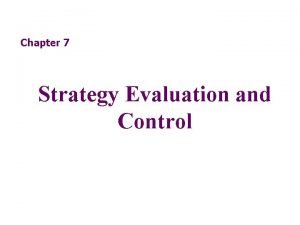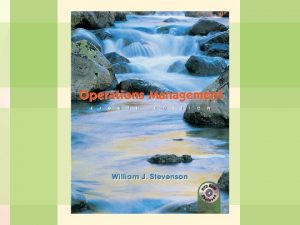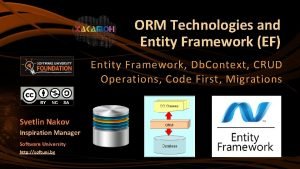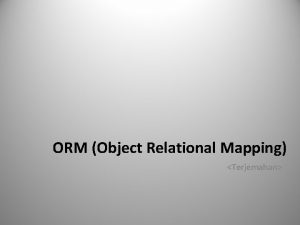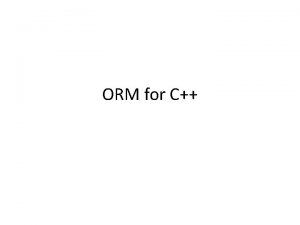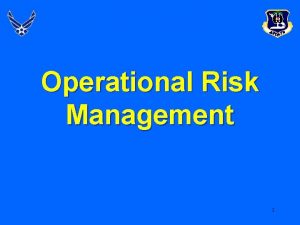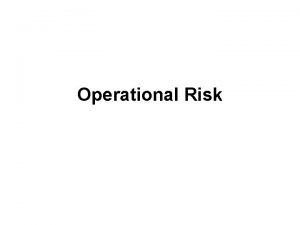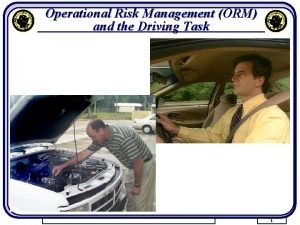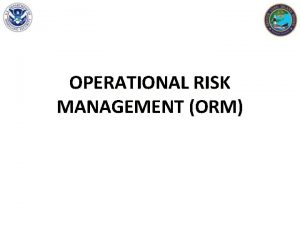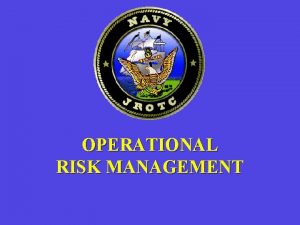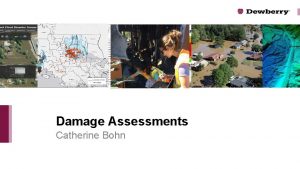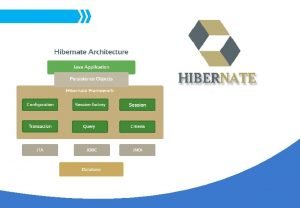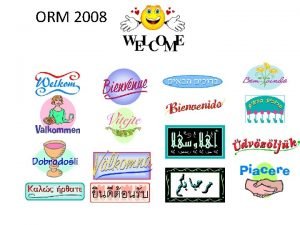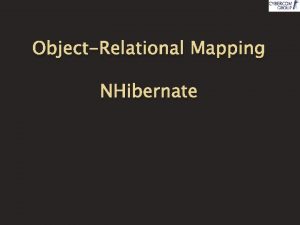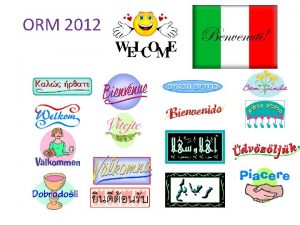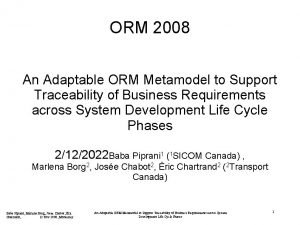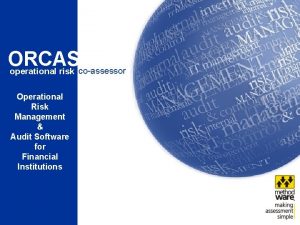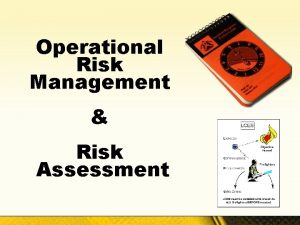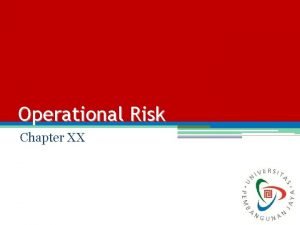Damage Control OPERATIONAL RISK MANAGEMENT ORM Unit 2





































- Slides: 37

Damage Control OPERATIONAL RISK MANAGEMENT (ORM) Unit 2. 13

ENABLING OBJECTIVES Describe • ORM Process • Hazard Identification Tools • Hazard Assessment Tools • Risk Assessment Tools • DC Roll

PRESENT A VIEW • WHERE WE ARE TODAY • WHERE WE WANT TO BE • HOW WE MIGHT REACH OUR DESIRED END STATE

REFERENCES • OPNAVINST 3500. 39 – OPERATIONAL RISK MANAGEMENT • OPNAVINST 5100. 19 (series) – NAVOSH PROGRAM MANUAL FORCES AFLOAT • OPNAVINST 5102. 1 (series) – NAVY & MARINE CORPS MISHAP & SAFETY INVESTIGATION, REPORTING, & RECORD KEEPING MANUAL • NAVSEA S 0400 -AD-URM-010/TUM – TAG-OUT USERS MANUAL • COMNAVSURFORINST 3502. 1 C – Surface Force Training Manual • NAVAL SAFETY CENTER – http: //www. safetycenter. navy. mil/


HOW YOU DOIN’

WHERE ARE WE TODAY? ? ? NAVY FY 05 50% REDUCTION FINAL STATUS

TODAY Common Perceptions NSC/TYCOM Observations • A Safety Program • Gap between • Only for On Duty leadership’s view of success and junior view • Used when doesn’t of ORM acceptance interfere with operations • Fleet familiarity vice knowledge • Use by higher commands is invisible • Widely varying degrees of cultural adoption • A worksheet drill • Most feel ORM is not • Programs used daily not viewed as RM used well • Training is underutilized and not focused on application

WHERE WE WANT TO BE • EVERY CMD & EVERY SAILOR OPERATE OUR FORCES OFF-DUTY ACTIVITIES

Definitions üHazard - A Condition with the Potential to Cause Personal Injury, Property Damage, or Mission Degradation. üRisk - An Expression of Possible Loss in Terms of Severity and Probability. üRisk Assessment - The Process of Detecting Hazards and Assessing Associated Risks. üORM - The Process of Dealing with Risk to Include Assessment, Decision-Making, and Control Implementation.

3 Levels of ORM 1. Time Critical - “On the Run” 2. Deliberate - 5 Step Process 3. In-Depth - Complete 5 Step Process With Detailed Analysis

4 Principles of ORM üAccept Risk if Benefits > Cost. üAccept no Unnecessary Risks. üManage by Planning. üMake Decisions at Right Level.

ORM Continuous 5. Supervise 4. Implement Controls 1. Identify Hazards 2. Hazard Assessment Continuous 3. Make Risk Decisions IT IS NOT A PROGRAM. IT IS A PROCESS!!!

1. Identify Hazards üOutline Operation’s Major Steps üIdentify Hazard(s) for Each Step and the Possible Cause(s)

2. Assess Hazards üPrioritize Identified Hazards by Determining the Potential Losses’: • Severity • Probability üInput Data to Matrix (Table)

3. Make Risk Decisions üConsider Risk Controls • Start w/ most Serious • Pick Controls to Reduce üBenefit > Risk? üDiscuss with Higher Authority if Necessary

4. Implement Controls üEngineering • Design Features (Fan Belt Guards, Life Lines) üAdministrative • Signs, EOSS, MLOC, Training üPPE • Barrier to Further Reduces Loss Potential • Float Coats, Cranials, Rubber Matting

5. Supervise üFollow up, Ensure Controls… • …Remain in Place • …Have the Desired Effect üWatch for Changes

US COAST GUARD ORM 7 Step Process vice USN 5 Step Very Similar w/ Minor Differences: Use 2 Separate Models for “Assess Risks” Step 1. GAR (Green, Amber, Red) Considers: Crew Experience, Environment, Event Complexity, Supervision, etc. 2. SPE (Severity, Probability, Exposure) Used for Very Specific Operations/Hazards Risk = S x P x E If Numbers Exceed Certain Limits…

CHANGE “CHANGE IS THE MOTHER OF ALL RISKS” üCQ Period üChange of Command üMission Growth üMishap üCompressed Schedule üWatch Turnover ²Fog ²Getting U/W ²Gun Shoot ²BECCE’s ²Night • New Dept Head • Inport • Personal • Holiday Weekend • New Aircrew

USS LEYTE GULF CG-55

BENEFITS OF RISK MANAGEMENT – Reduce Serious Injuries – Reduce Material Damage – Enhance Mission Accomplishment • Most Effective When it Becomes Integral to Ship’s Operations – Part of Every Brief

ORM Matrix üMatrix (Table) Used to Quantify Risks üHazard Severity & Mishap Probability Risk Assessment Code (RAC) = Hazard Severity…The “Worst Possible” Result Mishap Probability…How Likely is it? Risk Assessment Code…Expression of Risk

ORM Matrix • Hazard Severity – Category I- Death, Asset Loss, Grave National Interest Damage – Category II- Severe Injury, Assets Degraded, National Interest Damage – Category III- Minor Injury, Command / Service / Nat’l Interest Damage – Category IV- Minimal Threat to Personnel, Property or Cmd / Service / Nat’l Interest

ORM Matrix • Mishap Probability – Sub-Cat A- Likely Soon, Frequently to Individual, Continuously to Fleet – Sub-Cat B- Probable in Time, Often to Individual, Frequently to Fleet – Sub-Cat C- Maybe in Time, Sometime to Individual, Several Times to Fleet – Sub-Cat D- Unlikely to Occur

ORM Matrix • Risk Assessment Code (RAC) 1 - Critical 3 - Moderate 245 - Serious Minor Negligible

Operational Risk Management (ORM) MATRIX Assess the Hazards Likely Immediate Risk Assessment Code - ( RAC ) 1 = Critical 2 = Serious 3 = Moderate 4 = Minor 5 = Negligible CAT I = Death, Loss of asset. CAT II = Severe injury / degradation of asset. CAT III= Minor injury/ degradation of asset. CAT IV= Minimal injury/ degradation of asset. Probability of Occurrence A S E V E R I T Y Probably will occur in time May occur B C Cat I 1 1 2 Cat II 1 2 3 Cat III 2 3 4 Cat IV 3 4 Unlikely to occur D 3 4 5 5 5 Risk Levels Risk Assessment Code

FOUR RULES FOR SAFETY • IN-BRIEF • Deckplate Supervision • Uninvolved Safety Observers • Proper Tools & Procedures

HOW WE MIGHT REACH OUR DESIRED END STATE

UNIT IMPLEMENTATION * INDOC & GMT * During briefs * Regular Review of Instructions, SOPs * Use of Deliberate or In-depth ORM when planning New or unusual operations * ORM addressed at qualification boards

BEST PRACTICES 2005 ü ü ü ü LEADERSHIP BY E-MAIL: NOT!!! DEVELOP LEADERS NOW Establish MAX Liberty Distances & Flex Leave HRS Monitor PMV Safety Free Ride program Leave Assessments Guest Speakers Law Enforcement Partnerships

DC SPECIFIC. . . - Repairs/PMS to CHT system - Work on Installed CO 2 /Halon SYS - GFE Test in Fuel Tanks - Safety Walkthrough 1

DC SPECIFIC. . . - Chem-Bio Drill in the summer - Casualty Power Drill - Use of new “tools” for the first time. . . i. e. SCBA’s, OCENCO EEBD - OTHER 2

TRAINING TIME OUT • A training time may be called in any situation whenever a student or instructor expresses concern for personal safety or a need for clarification of procedures or requirements exist. TTO is also an appropriate means for a student experiencing undue pain, heat stress, or other serious physical discomfort to obtain relief. • Following a TTO , the training situation shall be examined and additional explanation and instruction will be provided as necessary to allow safe resumption of training. • The signal to start a TTO can be initiated by calling out “ TRAINING TIME OUT “ or by using a hand signal

DCTT ORM on Drill Package Hazard Severity Mishap Probability RAC COG WALK TO STATION/DC TT III C 4 DCTT LACK OF FLUIDS KEEP PERSON HYDRATED III C 4 DCTT WILD HOSE IMPROPER MANNING FOLLOW SAFETY PRECAUTIONS II D 4 DCTT SHORING CUTTING BODY PARTS INATTENTION TO CUTTING SHORE DCTT TO MONITOR III C 4 DCTT SCBA CHARGING LACERATION IMPROPER CHARGING DCTT MONITOR/ COMPLIANCE II D 4 DCTT PIPE PATCHING CUTTING BODY PARTS INATTENTION TO CUTTING WEDGES DCTT TO MONITOR III C 4 DCTT PORTABLE FF EQUIPMENT MISSLE HAZARD NOT LAYING EXTINGUISH ER ON DECK DCTT TO MONITOR III C 4 DCTT PERSONNEL INJURIE SAILOR MOVING UNDER HATCH/ SCUTTLE DCTT TO MONITOR III C 3 DCTT Event Hazard Cause KICK OFF OF DRILL TRIPPING RUNNING DEHYDRATI ON HOSEHANDLING HEAT STRESS SETTING ZEBRA ON HATCHES Precaution

ORM Scenario • MSF Drill sked for 0900 in MER 1 • Monday following 72 -hour lib • Freezing Rain- several crewmembers late • Underway on Wednesday for 1 week • ATG on board in 3 weeks for “inspection” • Disgruntled crew- sick of MSF Drills • “A” fire in MER 1 0430 • Yardbirds in MER 2, stuff torn up • 3 Senior DCTT Members on E-leave

CLOSING THOUGHTS ABOUT ORM SURFACE WARFARE EACH HAVE UNIQUE BEHAVIORS, RISKS, & TERMINOLOGIES. IT IS IMPORTANT TO RECOGNIZE THE CHARACTERISTICS OF EACH IN ORDER TO MAKE RISK DECISIONS TO ENSURE WE REMAIN OPERATIONALLY EFFECTIVE TO ACCOMPLISH THE MISSION…
 Concept of orm
Concept of orm 3 levels of orm
3 levels of orm Credit risk market risk operational risk
Credit risk market risk operational risk Operational risk management worksheet
Operational risk management worksheet Operational risk management wv
Operational risk management wv Operational risk management plan template
Operational risk management plan template Operational risk management worksheet
Operational risk management worksheet Benefits of operational risk management
Benefits of operational risk management First step of the orm process
First step of the orm process Inherent risks examples
Inherent risks examples Damage control engineering
Damage control engineering Damage control surgery
Damage control surgery Flood damage control
Flood damage control Nstm 079
Nstm 079 Fiduciary investment risk management association
Fiduciary investment risk management association Risk map risk management
Risk map risk management Sources of operational risk
Sources of operational risk Operational risk scenario
Operational risk scenario Loss event category
Loss event category Technology and other operational risks
Technology and other operational risks Techniques of strategic evaluation and control
Techniques of strategic evaluation and control Unit 10, unit 10 review tests, unit 10 general test
Unit 10, unit 10 review tests, unit 10 general test Lean operations management
Lean operations management Draw rmmm plan
Draw rmmm plan Risk management avoidance
Risk management avoidance Relative risk calculation
Relative risk calculation Residual risk and secondary risk pmp
Residual risk and secondary risk pmp Absolute risk vs relative risk
Absolute risk vs relative risk Thinking algebraically stock market game answer key
Thinking algebraically stock market game answer key Risk classification system
Risk classification system Pembiayaan risiko (risk financing)
Pembiayaan risiko (risk financing) The biggest risk is not taking any risks
The biggest risk is not taking any risks Ir x cr x dr
Ir x cr x dr Business risk vs financial risk capital structure
Business risk vs financial risk capital structure Attributable risk formula
Attributable risk formula Measure of association formula
Measure of association formula Orm technology
Orm technology Orm adalah
Orm adalah
